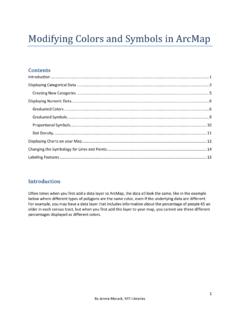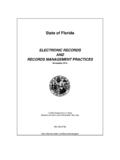Transcription of Data Management: File Organization - MIT Libraries
1 data management : File Organization Christine Malinowski January 21, 2016 data management Services @ MIT Libraries Contact: Workshops Web guide: Individual consultations includes help with creating data management plans IAP 2016 data management Plans and the DMPTool Tue Jan 26, 11am-12pm, 14N-132 LaTeX/BibTeX & Citation management Tools Thu, Jan 28, 11am-12pm, 14N-132 Why file Organization is important Today ? ? ? ? June The first person with whom you will share your data is yourself. Why file Organization is important And once your research gets underway, there may be multiple files in various formats, multiple versions, methodologies, etc., all relating to your research. ? ? ? ? Why file Organization is important Can someone else understand/use your data files?
2 Now? Tomorrow? In 5 years? ? ? ? ? Why file Organization is important Key principles of file Organization Spending a little time upfront, can save a lot of time later on. Be realistic: strike a balance between doing too much and too little. There s no single right way to do it; establish a system that works for you. Think about who your system needs to work for: Just you? You and your lab group? Collaborators? Key principles of file Organization Clear Concise Consistent Correct Conformant The 5 C s What do we mean by file Organization ? File structures file naming File versioning File structures where to put data so you can find it Method 1: Hierarchical Items organized in folders and subfolders Benefits: Familiar & widely used Good at representing the structure of information Similar items are stored together Subfolders can function as task lists Method 1: Hierarchical Items organized in folders and subfolders Drawbacks: Surprisingly hard to set up Challenging to get the right balance between breadth & depth Items can only go in one place Time consuming to reorganize if the hierarchy becomes out of date Method 1: Hierarchical best practices Avoid overlapping categories Method 1.
3 Hierarchical best practices Avoid overlapping categories Don t let your folders get too big Method 1: Hierarchical best practices Avoid overlapping categories Don t let your folders get too big Don t let your structure get too deep How many clicks does it take to get there? Method 2: Tag-based Each item assigned one or more tags Benefits: Items can go in more than one category Can be quicker/easier to set up When collaborating, it can be easier to combine than hierarchical systems data sharing data viz data comm Visual literacy RDM Method 2: Tag-based Each item assigned one or more tags Drawbacks: Not how operating systems store files If item isn t tagged properly when first acquired, it can be hard to find Increased risk of inconsistency Less good at representing the structure of information data sharing data viz data comm Visual literacy RDM Method 2: Tag-based See our guide to Tagging and Finding Your Files: Creating a tag-based system: In OS.
4 Add searchable keywords/tags to file information In bibliographic software: EndNote, Zotero, Image management programs: Flickr, Google tools Your file structure Hierarchical Tag-based Hybrid What sort of structure(s) do you currently use? What s working in this system? What s not working? Creating a systematic file folder structure Document your system and use it consistently Tips for defining your system: Define the types of data and file formats Include important contextual information Organize folders by meaningful categories primary/secondary/tertiary subject/collection method/time Choose a directory naming convention Be Clear, Concise, Consistent, Correct, Conformant A Case Study Creating a systematic file folder structure Type of data and file formats: Images (in multiple file formats) data in tabular format (some captured on the fly) about each specimen collected (visual characteristics, time, location, etc.)
5 data on weather from NOAA Project documents (grant proposal, etc.) PDFs of related literature And Creating a systematic file folder structure Include important contextual information: Date Collection method Collector .. Creating a systematic file folder structure Example file structure systems/directory hierarchy conventions: /[Project]/[Sub-project]/[Experiment]/[I nstrument]/[Date] /[Research area]/[Project]/[ data vs. documentation]/[Date] /[Project]/[Type of file]/[ data collector name]/[YYYYMMDD] For the butterfly project: /butterfly/images/mcneill/20160117 /butterfly/tabular/mcneill/20160117 /butterfly/projectDocs/ /butterfly/literature/ A quick word on organizing/storing articles Would I really want to store my literature files simply in a directory?
6 Maybe, Consider using citation management tools Tips for discovering your files Order dates beginning with the year to enable sorting by date ( , YYYYMMDD) Embed metadata in your files (if possible) Add shortcuts to files within other relevant folders file naming what to call data so you know what it is file naming conventions naming conventions make life easier! naming conventions should be: Descriptive Consistent Consider including: Unique identifier (ie. Project Name or Grant # in folder name) Project or research data name Conditions (Lab instrument, Solvent, Temperature, etc.) Run of experiment (sequential) Date (in file properties too) Version # file naming conventions naming conventions make life easier!
7 naming conventions should be: Descriptive Consistent YYYYMMDD MMDDYYYY YYMMDD MMDDYY MMDD DDMM Sample001234 Sample01234 Sample1234 TimeDate DateProjectID TimeProjectID Maintain order Include the same information file naming conventions best Practice Example Limit the file name to 32 characters (preferably less!) When using sequential numbering, use leading zeros to allow for multi-digit versions For a sequence of 1-10: 01-10 For a sequence of 1-100: 001-010-100 NO YES Don t use special characters & , * % # ; * ( ) ! @$ ^ ~ ' { } [ ] ? < > - NO Use only one period and use it before the file extension NO NO YES Avoid using generic data file names that may conflict when moved from one location to another NO YES Our case study Sashimi Microscope format Descriptive element Date as YYYYMMDD Initials because working in a group Ascension # because part of a series File format Maybe started with.
8 file naming & instrumentation Check to see if your instrument, software, or other equipment that outputs your data files can be set with a file naming system Less work than retrospectively changing filenames But if you still have to change many file names file naming & batch/bulk renaming Can use tools that retrospectively align file/folder names with naming conventions Caveats: Ideally you want to be able to map the original to new names Make sure it doesn t change the file extension Some File Renaming Tools: Bulk Rename Utility Renamer PSRenamer WildRename file naming & discipline standards Check for established file naming conventions in your discipline Some examples: DOE's Atmospheric Radiation Measurement (ARM) program GIS datasets from Massachusetts The Open Biological and Biomedical Ontologies File versioning keeping track of data Versioning: the why ?
9 ? ? ? Versioning: the when Depending upon practices in your field, version either: Analysis/program/script files data files themselves Also important for project documentation and files Versioning: the how Save new versions Establish a consistent convention v1 v2 v3 Versioning: the how Use ordinal numbers (1,2,3,etc) for major version changes and a decimal for minor changes Versioning: the how Use dates to distinguish between successive versions Not ideal when you can potentially have multiple versions in a day. Versioning: the how Avoid imprecise final labels Versioning: the how Put older versions in a separate folder Do you really need to keep obsolete versions? Versioning: the how Save new versions Establish a consistent convention v1 v2 v3 Document your convention Versioning: document it!
10 Some options: Create a version table or file history w/in or alongside your data files Use built-in capabilities of software (when available) Wikis, Google docs, etc. that track changes Platforms that allow for checking in/out files Setting permissions Use version control software Git, GNU RCS, Mercurial (Hg), etc. Versioning: the how Save new versions Establish a consistent convention v1 v2 v3 Document your convention Consider your version control needs Version control: general tip Be careful when syncing across platforms & simultaneously editing! Your turn! Understanding the structure of your own data . Allows others to understand your data . Establishes good practice early by helping form working habits.








